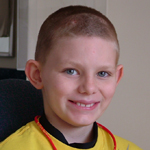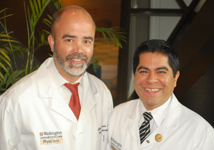Children with traumatic brain injuries are more likely to survive and avoid long-term disabilities when treated aggressively as part of a designated neurocritical care program that brings together neurologists, neurosurgeons, trauma and other critical-care specialists, according to a new study at Washington University School of Medicine in St. Louis.
The investigators tracked the results of such a program at St. Louis Children’s Hospital. They studied the outcome of 123 cases before and after the hospital launched a pediatric neurocritical care program (PNCP) in September 2005.
“We were amazed by the results,” says Jose A. Pineda, MD, assistant
professor of pediatrics and neurology, and director of the program at St. Louis Children’s. “We analyzed the data rigorously, and we found that our new program of care resulted in a striking improvement in outcome for children with severe traumatic brain injury. Mortality for these children was dramatically reduced, and we also noted a meaningful improvement in outcomes for survivors. We know that children who suffer traumatic brain injuries have long lives ahead and must reintegrate into society and be independent. That’s where we set the bar.”

The researchers’ findings are available online in the journal The Lancet Neurology. The study was led by Pineda, neurosurgeon Jeffrey R. Leonard, MD, and pediatric intensivist Allan Doctor, MD, who is chief of pediatric critical care at St. Louis Children’s.
“The study is the first to show benefits of a pediatric neurocritical care program,” Doctor says. “It is rewarding to see what a multidisciplinary team can accomplish when aggressively treating critically ill children with severe traumatic brain injury.”
St. Louis Children’s was one of the first U.S. hospitals to implement a PNCP, which it did with support from the St. Louis Children’s Hospital Foundation and the Sean Glanvill Foundation. Only six U.S. hospitals are believed to have one now, Pineda says. The closest to St. Louis Children’s is in Chicago.
The researchers examined the cases of 123 pediatric patients, ages 3 to 18, admitted with severe traumatic brain injuries to the intensive-care unit at St. Louis Children’s from July 1999 through January 2012.
After the hospital implemented its pediatric neurocritical care program, children had markedly better outcomes. Seven patients in this high-risk group (11 percent) died in the six years before the program was put in place, compared with two deaths (3 percent) in the six years after it was created.
Before the program, 33 of 63 patients (52 percent) either died or were admitted to a long-term care facility after being discharged from the hospital. But after the program was instituted, 20 of 60 patients (33 percent) had such an outcome.
The program’s aggressive approach to treating head injuries suffered in car, bicycle, sports-related and other such accidents targets secondary damage, especially damage provoked by dangerous increases in intracranial pressure. Among complications the team pays close attention to is brain swelling, which increases pressure inside a child’s skull, limiting blood flow to the brain. Because that blood flow is necessary to deliver oxygen and nutrients to the brain, the PNCP protocol calls for intracranial pressure monitoring and aggressive therapies that reduce such increases in pressure.
“Our data shows that intracranial pressure monitoring was implemented
earlier and sustained longer after implementation of the PNCP,” Pineda says. “More importantly, the PNCP also resulted in increased intensity of therapies targeting intracranial pressure in the first three days of the patient’s treatment. That is one of the explanations for improved outcomes for children after our program was put in place.”

Now that there is proof that PNCPs do make a significant difference, Pineda and his fellow researchers have two key goals: to sustain the outcomes they’ve seen since the program was created at Children’s, and to spur other institutions to implement their own such programs.
“Other health-care professionals are going to read this paper and say, ‘I knew this was possible, but now there is evidence that this aggressive, careful approach to patients with brain injury actually can make a difference,’ and they’re going to try to do it,” Pineda says. “Our next task is to work with other Washington University specialists to develop a formula for implementing a program like this at other institutions.”
Pineda credits the success of the program in large part to a close partnership with colleagues in neurosurgery, neurology, trauma surgery and radiology. The program also boasts a full-time clinical nurse coordinator, data manager and research specialist, and its team members undergo frequent and comprehensive training, he says.
“In particular, we couldn’t have achieved these results without the leadership of Dr. Jeff Leonard, the PNCP co-director and senior neurosurgeon on the team,” Pineda says. “We were also fortunate to work with Jeff Gill, a skilled biostatistician who developed the powerful model illustrating the program’s impact on outcomes across the full spectrum of injury severities.
“We developed this collaborative, highly choreographed clinical pathway after first forging a partnership in caring for individual cases together. It’s incredibly rewarding to see synergy emerge after bringing our teams together to form the PNCP.”
A commentary about the study in The Lancet Neurology praises Pineda and his colleagues and says the research shows that “rational, protocol-driven neurocritical care, meticulously applied, can deliver outcome improvements.”
Pineda JA, Leonard JR, Mazotas IG, Noetzel M, Limbrick DD, Keller MS, Gill J, Doctor A. Effect of implementation of a paediatric neurocritical care programme on outcomes after severe traumatic brain injury: a retrospective cohort study. The Lancet Neurology. Online Nov. 28, 2012.
The PNCP was established with support from the St. Louis Children’s Hospital Foundation and the Sean Glanvill Foundation.
Washington University School of Medicine’s 2,100 employed and volunteer faculty physicians also are the medical staff of Barnes-Jewish and St. Louis Children’s hospitals. The School of Medicine is one of the leading medical research, teaching and patient care institutions in the nation, currently ranked sixth in the nation by U.S. News & World Report. Through its affiliations with Barnes-Jewish and St. Louis Children’s hospitals, the School of Medicine is linked to BJC HealthCare.